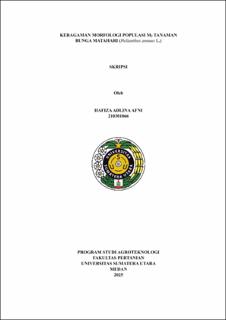Keragaman Morfologi Populasi M2 Tanaman Bunga Matahari (Helianthus annuus L.)
Morphological Diversity of the M2 Population of Sunflower Plants (Helianthus annuus L.)
Abstract
Sunflowers (Helianthus annuus L.) are plants from the Compositae family that are used in food, cosmetics, and agriculture. However, the production of sunflowers used for commercial purposes has not yet reached its full potential, necessitating the use of superior varieties to enhance sunflower diversity. This study aims to investigate the genetic diversity resulting from gamma radiation-induced mutations in the M2 population of sunflower plants of the IPB BM1 variety. The research was conducted at the Faculty of Agriculture, University of North Sumatra, from November 2024 to April 2025. This study employed descriptive statistical analysis methods, consisting of two treatments: the IPB BM1 variety with an M2 population resulting from gamma ray irradiation at a dose of 100 Gy, and the use of genetic and environmental variance analysis, as well as heritability values. Overall, the effect of the 100 Gy gamma radiation treatment on the M2 population showed significant differences compared to the control plant population, except for the number of flower branches, and one individual plant showed a significant decrease in plant height. The highest genetic variance was found in the number of main flower seeds, with moderate heritability. Morphological changes were observed in the mutant plants, particularly in the leaves and flowers. The leaves exhibited changes in shape, characterized by folds on both sides, and the flowers showed changes in corolla shape, with uneven sizes and spacing.
Collections
- Undergraduate Theses [3569]

